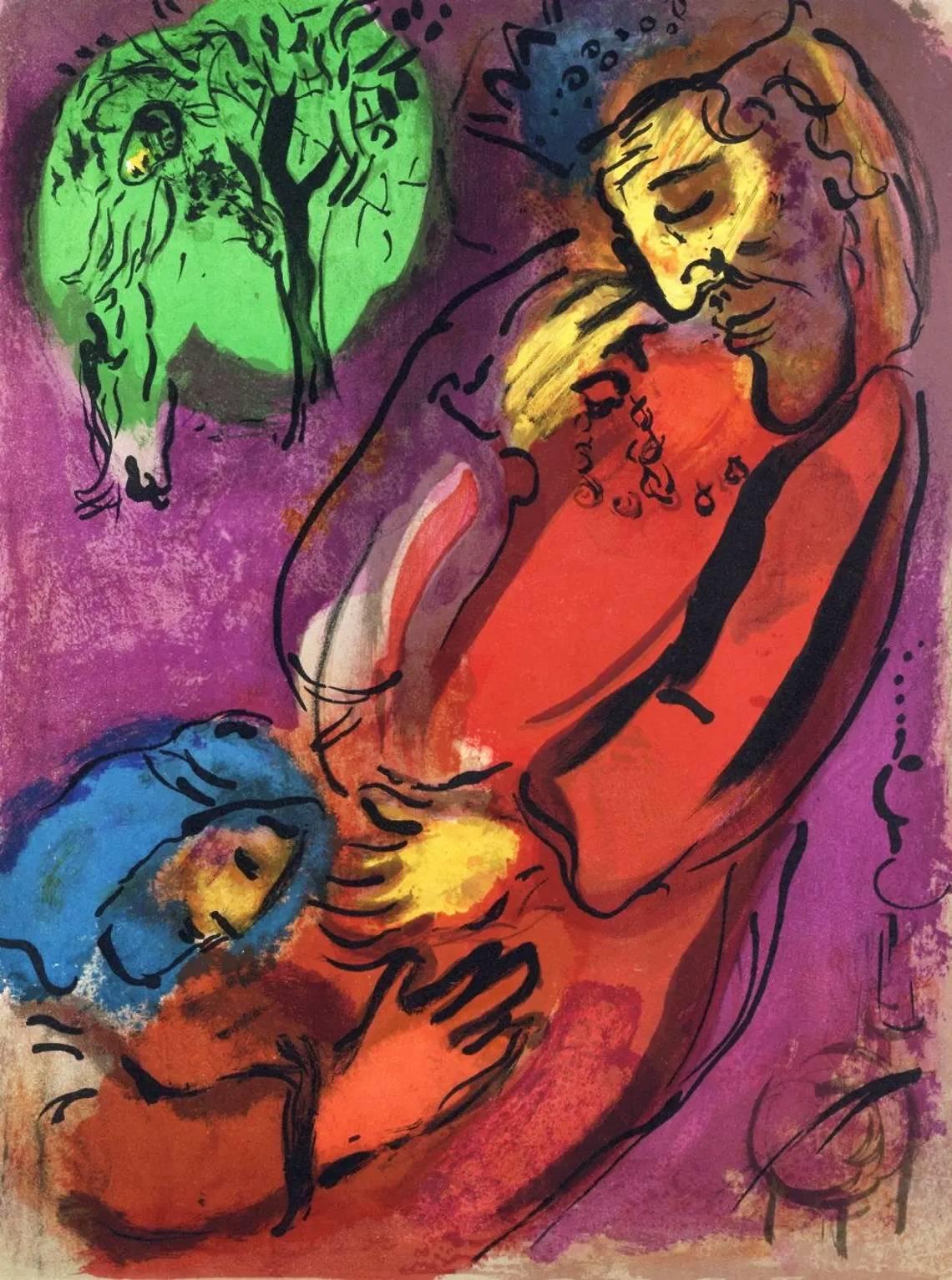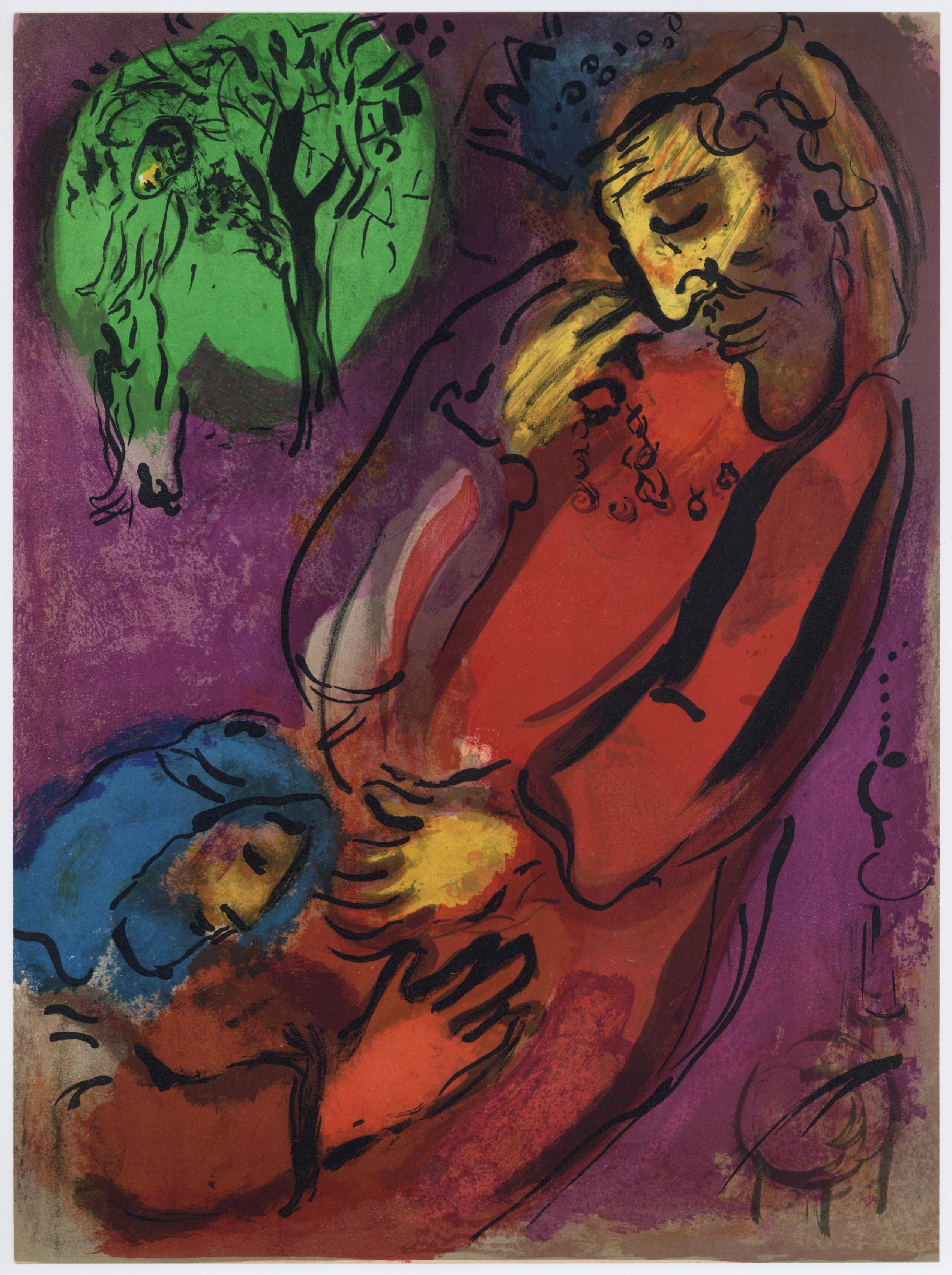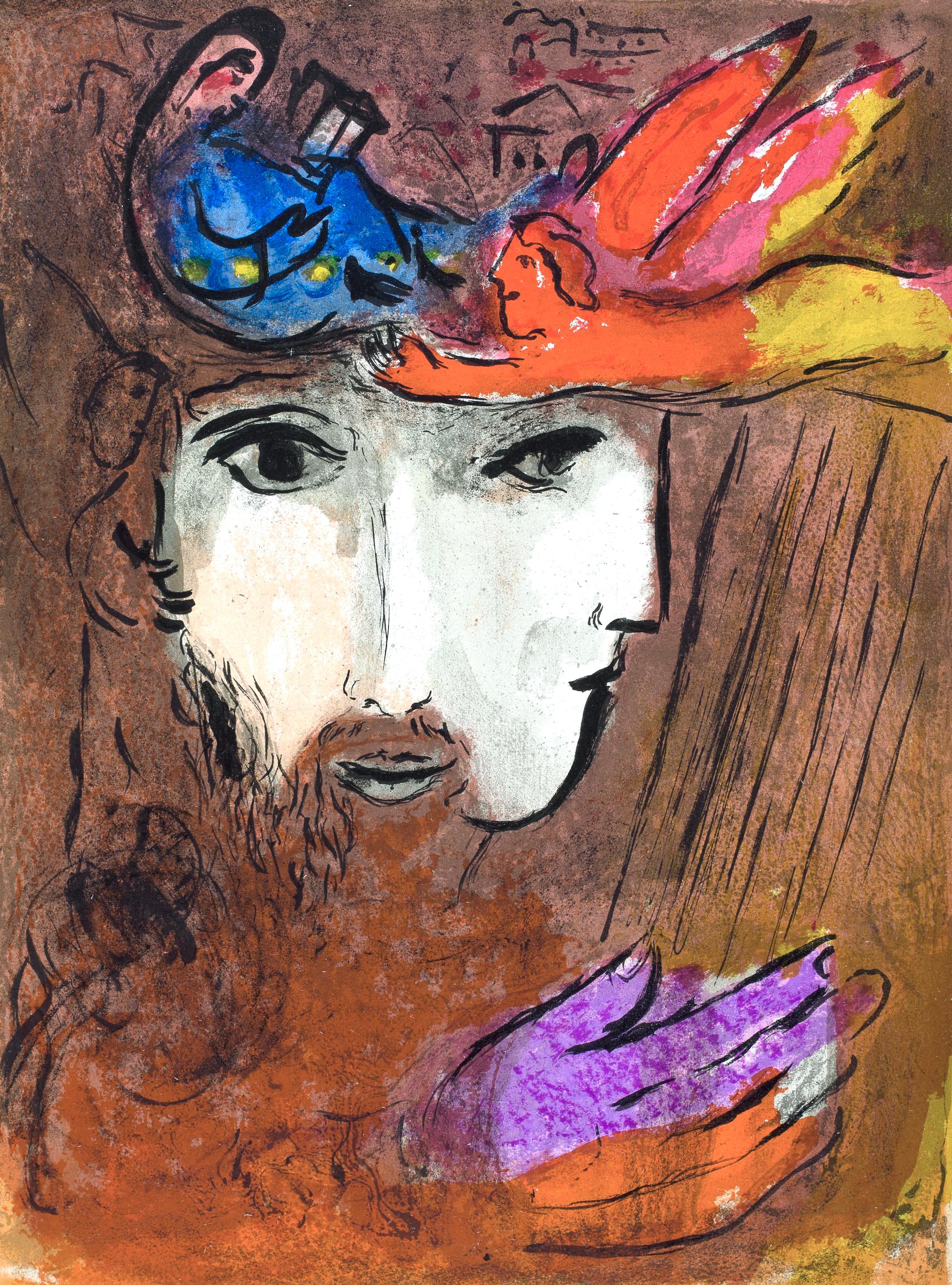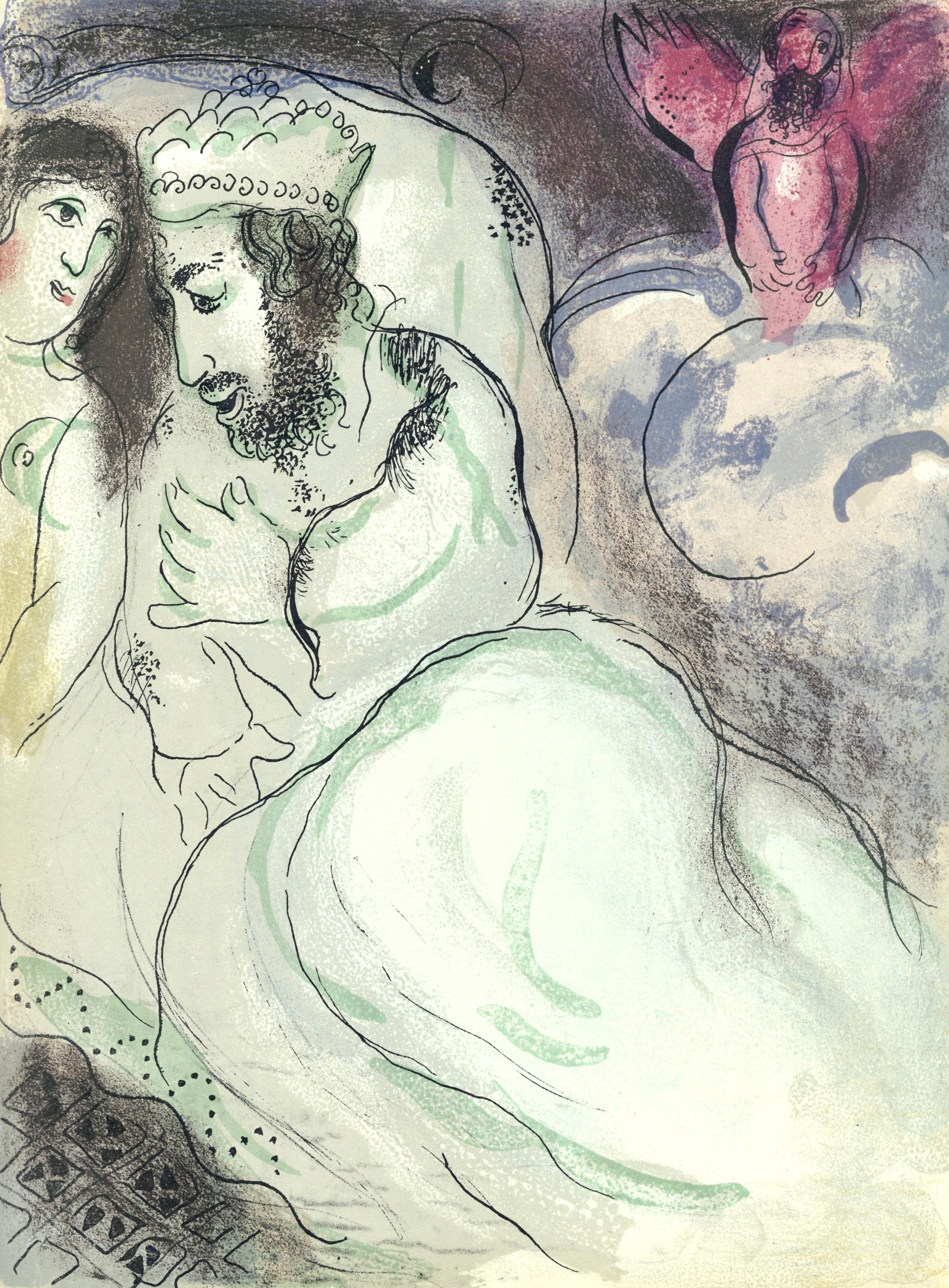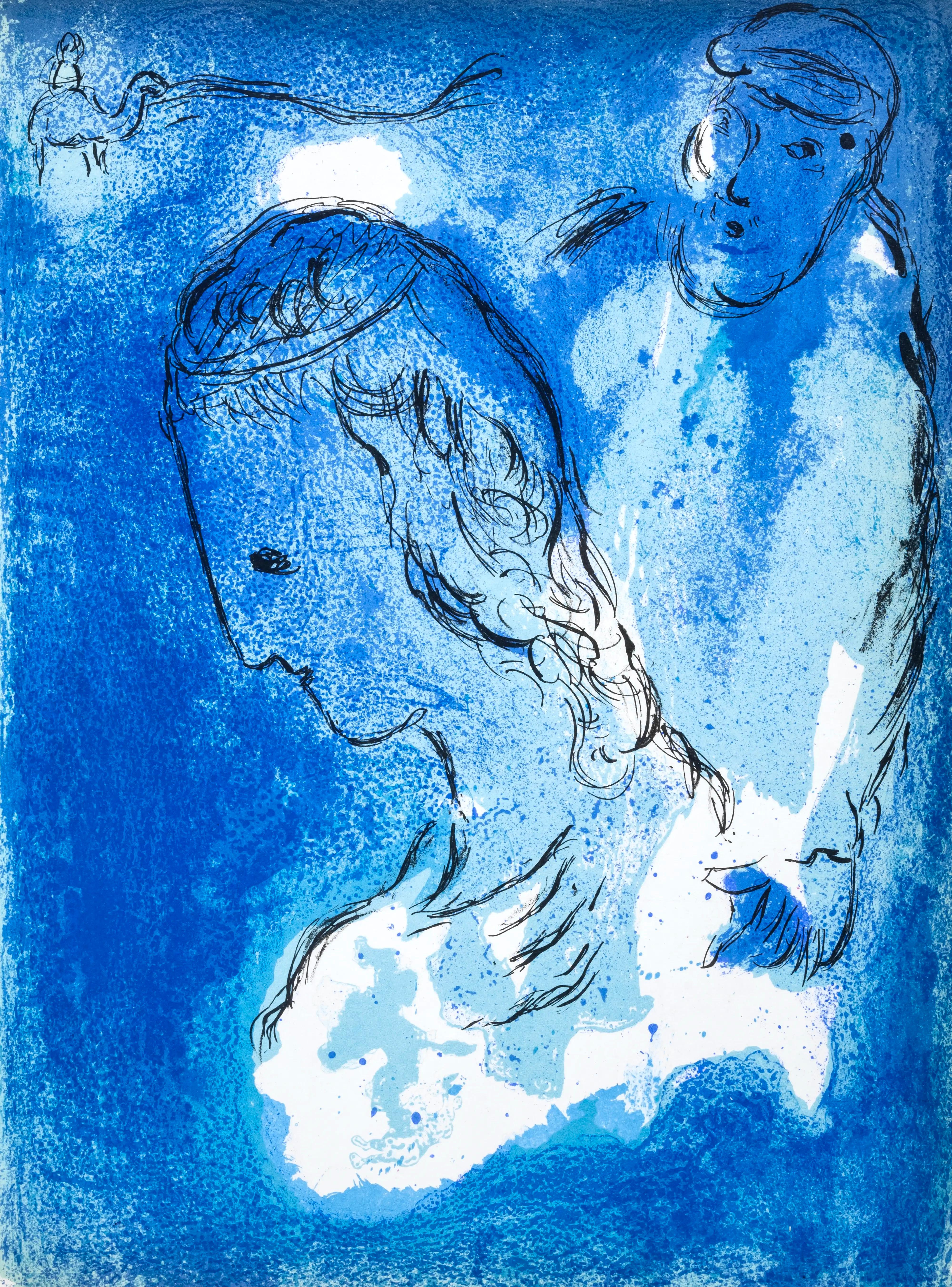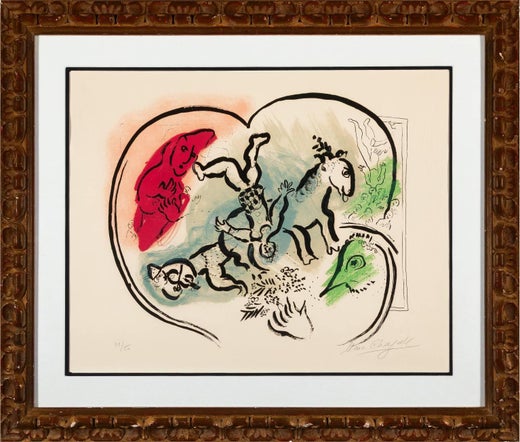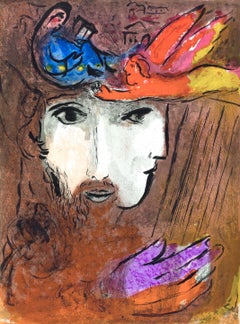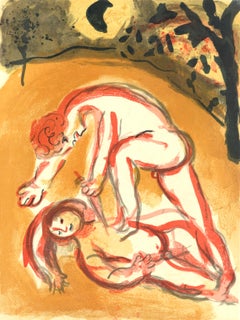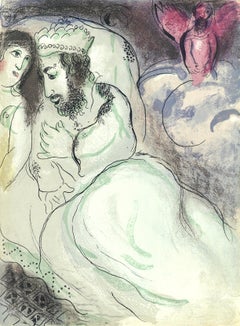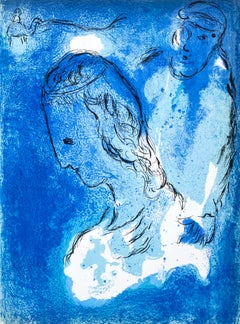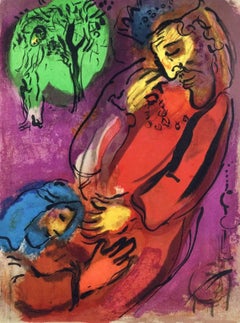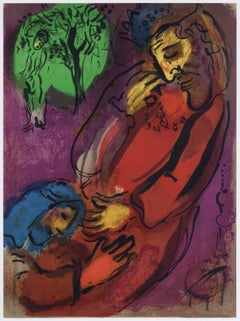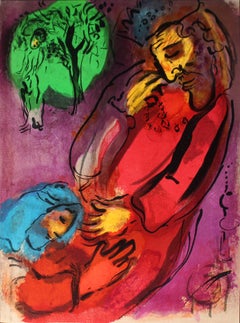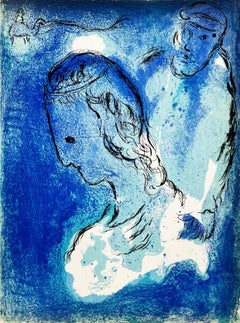Lithographie sur papier vélin des Papeteries du Marais. Taille du papier : 14 x 10.25 pouces. Inscription : Non signé et non numéroté, tel que publié. Références du catalogue raisonné : Cain, Julien, et Fernand Mourlot. Chagall Lithographe. André Sauret, Éditeur, 1960, illustrations 117-46. Cramer, Patrick, et Meyers. Marc Chagall : Catalogue Raisonné Des Livres Illustrés. P. Cramer, 1995, illustration 25. Notes : Extrait de l'album Marc Chagall, Dessins Pour La Bible, Verve : Revue Artistique et Littéraire, Vol. VIII, N° 33 et 34, septembre 1956. Publié par les Éditions de la revue Verve, Paris, sous la direction de Tériade, éditeur, Paris ; imprimé par Mourlot Frères, Paris, le 10 septembre 1956 dans un tirage de V̅MD. Ce double numéro de Verve est consacré à la reproduction intégrale en héliogravure des cent-cinq planches gravées par Marc Chagall, entre 1930 et 1955, pour l'illustration de la Bible. L'artiste a composé spécialement pour le présent ouvrage, seize lithographies en couleur et douze en noir, ainsi que la couverture et la page de titre. Ce volume a été achevé d'imprimer le 10 septembre 1956 par les maîtres imprimeurs Draeger Frerés pour l'héliogravure, et par Mourlot Frères pour la lithographie. Notes complémentaires : Extrait de Poppy Sfakianaki, 'La revue Verve (1937-60) : Un tremplin pour la carrière de Tériade dans les éditions d'art', Journal of European Periodical Studies, 4.2 (Winter 2019), 70-89, En 1937, Tériade (1897-1983) rencontre David Smart (1892-1952), l'éditeur américain du magazine Esquire, qui lui propose de collaborer à la création du 'plus beau magazine du monde'. Smart reconnaît en Tériade non seulement ses capacités d'éditeur et ses connaissances en histoire de l'art, mais aussi son réseau professionnel et le nom qu'il s'est fait dans le monde de l'art parisien, autant d'atouts cruciaux pour une entreprise éditoriale. Ayant eu la conviction commerciale que la beauté "fait vendre", Smart entendait s'adresser au public américain, attiré par l'art français, y compris l'art moderne, et le mythe de la vie artistique à Paris. Pour sa part, Tériade voit dans cette Collaboration l'occasion d'une incursion sur le marché américain, puissant allié de l'art moderne en France. Les Éditions de la Revue Verve ont été fondées en novembre 1937, financées en grande partie par Smart, et dirigées par Tériade. Verve : Revue Artistique et Littéraire était une publication artistique luxueuse et ambitieuse, publiée non seulement en français, mais aussi en anglais dans les premières années, et distribuée en Europe et aux États-Unis. Sa configuration rappelle celle des revues françaises Cahiers d'art, Minotaure et Arts et métiers graphiques, ainsi que celle de la revue d'art américaine Coronet. Cependant, Verve était supérieur à la concurrence en raison de son iconographie abondante et de sa grande qualité d'impression. Son prix variait entre 60 et 150 francs (pour les numéros doubles) avant la guerre, et entre 120 et 350 francs pendant la guerre. Compte tenu de son prix élevé, le magazine s'adressait principalement aux marchands d'art, aux collectionneurs, aux bibliophiles et aux amateurs d'art fortunés. L'esthétique raffinée de la revue est due à son rédacteur en chef, Tériade, qui a cherché à développer une plate-forme de dialogue entre l'image et le texte, les arts visuels et la littérature. La dominante de chaque numéro reste son iconographie, composée de reproductions d'œuvres d'artistes modernes que Tériade admirait, et de " maîtres ", principalement de la tradition française, à côté de photos et de miniatures de manuscrits médiévaux. Tériade a sans doute réalisé avec sa revue une idée exprimée en 1934 selon laquelle les livres servaient de "musée idéal" ou d'exposition où sont rassemblés tous les chefs-d'œuvre artistiques, que Malraux développera plus tard dans Le Musée imaginaire (Genève : Skira, 1947), dont certaines parties paraîtront dans Verve. Pendant la Seconde Guerre mondiale, la périodicité de la revue a changé, devenant irrégulière, et la nature des sujets traités moins variée. Ainsi, les numéros publiés pendant la guerre (ainsi qu'en 1945 et 1946) sont exclusivement consacrés à la reproduction d'enluminures médiévales. Enfin, les numéros spéciaux de l'après-guerre présentent chacun la production récente d'un peintre d'art moderne. Seuls les numéros 8 (1940) et 27-28 (1952) font exception avec un résumé plus varié. L'accueil de Verve a été positif, comme en témoignent plusieurs articles de presse élogieux tout au long de sa diffusion. Le succès de la revue, la passion de Tériade pour l'art moderne et les manuscrits médiévaux, son admiration pour les publications d'Ambroise Vollard et d'Albert Skira, sa connaissance du monde des bibliophiles, l'amènent bientôt à amplifier son activité éditoriale. En 1943, malgré les difficultés pratiques imposées par la guerre, paraît son premier livre d'artiste, écrit et illustré par Georges Rouault. Jusqu'en 1975, Tériade publie aux Éditions de la Revue Verve, neuf livres d'artistes modernes, tels que Henri Matisse, Pablo Picasso, Marc Chagall, Joan Miró, entièrement composés (texte et images) par les artistes ; dix-sept livres illustrés par des artistes modernes reconnus ; un album de lithographies de Fernand Léger sur Paris ; deux albums photographiques d'Henri Cartier-Bresson ; deux monographies des artistes André Beaudin et Francisco Borès ; une luxueuse série de reproductions d'enluminures médiévales ; et une série de portfolios sur la grande architecture française. En définitive, l'étude comparative de la revue et des éditions de Verve : Revue Artistique et Littéraire illustre l'importance de la dynamique relationnelle tacite qui résulte des relations de collaboration et d'échange de capital symbolique fondées sur des perceptions et des intérêts communs, ainsi que sur des sentiments d'amitié et d'appréciation mutuelles d'acteurs du monde de l'art qui partagent une culture visuelle et bibliophilique et contribuent ainsi au succès de la revue et de la maison d'édition.
MARC CHAGALL (1897-1985) était un artiste franco-russe. Moderniste avant l'heure, il a été associé à l'École de Paris ainsi qu'à plusieurs styles artistiques majeurs et a créé des œuvres dans un large éventail de formats artistiques, notamment la peinture, les dessins, les illustrations de livres, les vitraux, les décors de théâtre, les céramiques, les tapisseries et les gravures d'art. Chagall est né dans une famille juive près de Vitebsk, aujourd'hui en Biélorussie, mais à l'époque dans le Pale of Settlement de l'Empire russe. Avant la Première Guerre mondiale, il voyageait entre Saint-Pétersbourg, Paris et Berlin. Durant cette période, il a créé son propre mélange et son propre style d'art moderne, basé sur ses idées du folklore d'Europe de l'Est et du folklore juif. Il a passé les années de guerre dans son pays natal, la Biélorussie, devenant l'un des artistes les plus éminents du pays et un membre de l'avant-garde moderniste, fondant le Vitebsk Arts College. Il travaille ensuite à Moscou et dans ses environs, dans des conditions difficiles, pendant les temps durs que connaît la Russie à la suite de la révolution bolchevique, avant de repartir pour Paris en 1923. Pendant la Seconde Guerre mondiale, il a fui la France occupée pour se rendre aux États-Unis, où il a vécu à New York pendant sept ans avant de revenir en France en 1948. Le critique d'art Robert Hughes a qualifié Chagall de "quintessence de l'artiste juif du vingtième siècle". Selon l'historien de l'art Michael J. Lewis, Chagall était considéré comme "le dernier survivant de la première génération de modernistes européens". Pendant des décennies, il "a également été respecté comme l'artiste juif le plus éminent du monde". En utilisant le vitrail, il a réalisé des vitraux pour les cathédrales de Reims et de Metz ainsi que pour le Fraumünster de Zürich, des vitraux pour l'ONU et l'Art Institute of Chicago et les Jerusalem Windows en Israël. Il a également réalisé des peintures de grande envergure, dont une partie du plafond de l'Opéra de Paris. Il a connu "l'âge d'or" du modernisme à Paris, où "il a synthétisé les formes d'art du cubisme, du symbolisme et du fauvisme, et l'influence du fauvisme a donné naissance au surréalisme". Pourtant, tout au long de ces phases de son style, "il est resté très clairement un artiste juif, dont l'œuvre était une longue rêverie sur la vie dans son village natal de Vitebsk". "Lorsque Matisse mourra", remarquait Pablo Picasso dans les années 1950, "Chagall sera le seul peintre restant à comprendre ce qu'est vraiment la couleur".
